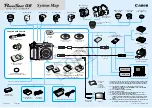
22 |
Command
Optional Payload
Description
cs dumptbl
Displays camera sensor register default table data to
console (store in camera)
cs dump
Displays current sensor register settings read from
sensor on the console
cs init
Initialize the camera sensor using default settings
cs rd
xx
Reads camera sensor register address xx and display
value on the console
cs wr
xx dd
Write camera sensor register address xx with value dd
cs save
user
Save current sensor register settings as power on
default (the gain and exposure settings will be ignored
and the value entered in under the agc setup will be
used)
cs tp
0
1
Disables sensor test pattern
Enables sensor test pattern
A list of all possible registers for the “cs wr” and “cs rd” is given in Table 10. It is recommended to refer
to the LYNX CMOS datasheet for further explanation of the sensor register settings. Typical usage of
the “cs wr” and “cs rd” command should be as follows:
Writing register:
CS wr <Address> <Value><CR><LF>
Reading register
CS rd <Address><CR><LF>
Table 10: CMOS Sensor Registers
Name
Address Size
Description
SENSOR_ACTIVE
0
1
Disable/Enable continuous grabbing of images;
external SENSOR_ACTIVE pulses are ignored
60FPS
1
1
Use 2 or 4 output channels, resulting in 60fps or 100
fps operation
ADDR_Y
2-3
11
The start address of the readout window.
Valid range for this register is 0 to 1044-SIZE_Y.
SIZE_Y
4-5
11
The number of rows in the readout window.
Valid range for this register is 1 to 1044
NROF_SLOPES
6
2
The number of slopes is 1, 2 or 3.
‘0’ is an invalid setting for this register.
INTE_FIRST
7-9
24
The number of slots light integrates on the pixels for the
1st first slope of the response curve.
The default value yields the maximum integration time
available while maintaining the desired maximum frame
rates of 60fps and 100fps. A longer integration time will
decrease the frame rate.
‘0’ is an invalid setting for this register.
NVT 200-LC-4019
©2015 PHOTONIS Digital Imaging LLC
Revision: C.04
All Rights Reserved
Page 22 of 39
















































